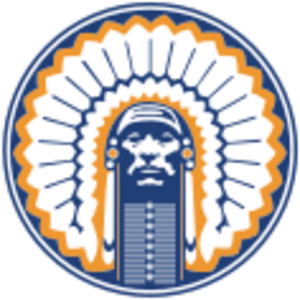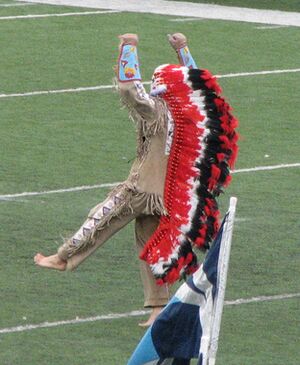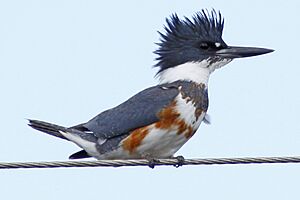Chief Illiniwek facts for kids
Chief Illiniwek was a student who performed as a symbol for the University of Illinois Urbana–Champaign (UIUC) sports teams. This tradition lasted from 1926 to 2007. The student dressed in clothing similar to that worn by the Sioux people. The Chief performed during halftime at football and basketball games, and sometimes at women's volleyball matches.
For over 20 years, Chief Illiniwek was part of a big debate. Some fans and alumni saw the Chief as an important university tradition. However, many Native American groups, scientists, and teachers felt that using such symbols was disrespectful. They believed it took from Native American cultures and spread harmful stereotypes. In 2005, the NCAA called Chief Illiniwek one of 19 mascots that were "hostile or abusive." They made a rule that schools using such mascots could not fully join in postseason sports events.
The University of Illinois stopped the Chief Illiniwek tradition in 2007. The last official performance was on February 21, 2007. The university has not chosen a new mascot yet. In 2019, students voted on "Alma Otter" as a possible new mascot, but it did not win. In 2020, the belted kingfisher bird received the most student votes. Later that year, the University Senate strongly supported the kingfisher as a new mascot. While many on campus like the kingfisher, some alumni still want Chief Illiniwek to return.
Some people who supported Chief Illiniwek did not like the word "mascot." They preferred to call the Chief a "symbol" of the university.
Contents
What was Chief Illiniwek?
Chief Illiniwek and the Chief Illiniwek logo were symbols of the University of Illinois. The logo showed a Native American face with a headdress. The university controlled how this logo was used because of the ongoing debate. It is important to know that Chief Illiniwek was not a real person or a historical Native American chief.
Even though some called the Chief a "symbol," most news and academic sources referred to him as the university's mascot. This is because he did many things other school mascots do. In his final years, the Chief did not perform at games held at other universities. This was because some other Big Ten schools felt the character was offensive.
A student was chosen to portray Chief Illiniwek after an audition. The student wore real Lakota (Sioux) clothing. The performance included a dance. This dance was created based on what the first performers learned in the Boy Scouts of America. It was taught by Ralph Hubbard, who organized "Indian pageants." The dance was performed to the university band's "Three in One" music. This music included songs like "The March of the Illini" and "Hail to the Orange".
How Chief Illiniwek Started
The idea for Chief Illiniwek came about in 1926. Ray Dvorak, who helped direct the university bands, thought of having a Native American war dance at football game halftimes. The first performance was on October 30, 1926, at Memorial Stadium. It was during a game against the University of Pennsylvania. After his dance, the Chief met the University of Pennsylvania's Quaker mascot. They shared a peace pipe and walked off the field together.
Lester Leutwiler, a student and Eagle Scout, made the first costume. He performed the dance based on his Boy Scout experiences. The name "Illiniwek" means "the complete human being." It was first used for the University of Illinois football team by coach Bob Zuppke. He was referring to the Illinois Confederation of Native Americans who lived in the area that is now Illinois.
Another student, A. Webber Borchers, was the only Chief to ride a horse around the field. He helped make the Chief tradition stronger. He also helped raise money for a permanent costume in 1930. The costume was changed several times over the years. The last costume was bought from Frank Fools Crow, a chief of the Oglala Sioux people. His wife sewed it. Chief Fools Crow visited the campus in 1982 to present the clothing. The costume originally had real eagle feathers. However, eagle feathers are sacred to Native Americans and protected by law. So, the feathers were later replaced with dyed turkey feathers.
A total of 36 different students officially played the role of the Chief. Only one was a woman, Idelle (Stith) Brooks, who performed in 1943 during World War II. She was called "Princess Illiniwek." None of the students who portrayed Chief Illiniwek were of Native American heritage.
The actual descendants of the Illiniwek people did not support the Chief. In 1995, the chief of the Peoria Tribe of Indians of Oklahoma said they had no problem with the mascot. But by 2000, the tribal council, with a new chief, passed a rule against the university using the Chief. In 2007, the Oglala Sioux Tribal Council also asked the University of Illinois to return the clothing to Frank Fools Crow's family and stop using the Chief Illiniwek mascot.
The Chief also appeared in the university's homecoming parade and pep rally until 1991.
Chief Illiniwek and the Fighting Illini Name
Some people mistakenly think Chief Illiniwek and the "Fighting Illini" nickname are linked to Native American traditions. However, the name Illini was first used for the school in 1874 by the student newspaper.
The word "fighting" was added about five years before Chief Illiniwek appeared. It was a way to honor Illinois soldiers who died in World War I. The football stadium, Memorial Stadium, was also named for these soldiers. The NCAA has said that the names "Illini" and "Fighting Illini" are allowed. This is because they are based on the name of the state, not a specific Native American tribe.
The state of Illinois was named by French explorers after the Illiniwek people. These were a group of Algonquian tribes who lived in the area. The word Illiniwek means "those who speak in the ordinary way."
Retiring Chief Illiniwek
On February 16, 2007, the head of the university's board of trustees decided to retire Chief Illiniwek. The last performance was by Dan Maloney on February 21, 2007. It happened at the last men's home basketball game of the season against Michigan. The next night, February 22, 2007, was the first women's basketball game without Chief Illiniwek.
On March 13, 2007, the University of Illinois board of trustees voted to officially retire the Chief's name, image, and clothing. In February 2007, the National Congress of American Indians thanked the university for retiring Chief Illiniwek.
After the Retirement
On October 4, 2009, the University of Illinois gave the Chief Illiniwek clothing back to the Oglala Lakota people. The university did not make a public statement about this event.
Students and fans still chant "Chief" during the "Three In One" performance at halftime. Since the university cannot control what fans chant, some groups have asked for the "Three In One" performance to be banned too.
In 2014, a Native American student, Xochitl Sandoval, wrote a letter to the university. She described how she felt insulted by the continued presence of "The Chief" on campus. This included other students wearing old Chief images and unofficial performances by a student named Ivan A. Dozier. She felt the university was not doing enough to stop a hostile environment for Native American students. After her letter, a gathering was held on campus to support Sandoval and ask the university to do more.
In 2016, the university announced it was looking for its "first-ever athletic mascot." This phrase seemed to acknowledge that some Chief supporters called the Chief a "symbol" and not a "mascot."
In 2017, University Chancellor Robert Jones decided to ban the school's "War Chant" music. Critics said the music stereotyped Native Americans and kept the debate about Chief Illiniwek going. Chancellor Jones said debating it further would only cause more pain for the university.
Later in 2017, a protest happened during the school's homecoming parade. This was because an unofficial Chief performer marched with a group called the Honor the Chief Society. An incident occurred involving a police officer near the Chancellor’s car. The next morning, some members of a Sioux nation held a powwow on campus. They had a banner that said "The Fighting Sioux Support the Fighting Illini." These performers were part of an organization called NAGA (Native American Guardians Association). Their goal was to educate people about Native American culture, not to remove traditions.
New Mascot Ideas
The University of Illinois Urbana-Champaign has not yet chosen a new official mascot. As mentioned, "Alma Otter" was proposed but did not win a student vote in 2019. In 2020, the belted kingfisher received the most student votes. This bird lives in Illinois, and the female kingfisher is orange and blue, matching the university's colors. In September 2020, the University Senate strongly supported the kingfisher as the new mascot.
Many groups support the kingfisher as a mascot, including the American Indian Center of Chicago and the Champaign Audubon Society. In December 2022, the National Congress of American Indians supported efforts to find a new mascot. Supporters of the kingfisher say the bird is "naturally true to the orange and blue."
Unofficial Chief Performers
In April 2008, a group of former Chief Illiniwek performers, called the "Council of Chiefs," chose a student to portray the Chief. This performance was not approved by the university. Logan Ponce was chosen as the 37th performer. He hoped to bring the Chief tradition back to the university.
In 2010, the Students for Chief Organization chose Ivan A. Dozier, who has Cherokee ancestry, as the 38th Chief performer. Dozier performed at events and sporting games. When he graduated, Bennett Kamps was chosen to replace him in 2016. The current unofficial performer is Omar Cruz Aranda.
Unofficial Performances and Events
An event called "Students for Chief Illiniwek Presents: The Next Dance" took place on November 15, 2008. It happened after a football game. The Native American House on campus asked the university community to speak out against the event.
In 2010, emails were released that showed university leaders trying to stop these unofficial performances. The emails showed conversations about trying to find reasons to deny students access to the Assembly Hall for performances. This raised concerns about free speech.
In October 2012, the Chief made an unapproved halftime appearance at a homecoming football game.
In January 2015, an unofficial appearance by former performer Ivan A. Dozier at a high school was canceled. School officials removed the announcement online because of negative comments. They said the cancellation was to ensure student and community safety.
In February 2018, groups encouraged fans to wear "Chief" clothing to a basketball game. This event was called "Paint the Hall Chief." The university asked Facebook to remove the event because of copyright concerns, but Facebook refused. At the game, about 100 protestors gathered, holding signs and chanting against the Chief.
University Efforts to Resolve the Debate
The current chancellor, Robert J. Jones, has worked to resolve the debate. A committee held "critical conversations" with over 600 people from all sides. The committee found that opinions remain very divided. The chancellor then created a Commission on Native Imagery: Healing and Reconciliation to follow up on the committee's ideas.
In 2019, the Chancellor's Office released a report with four main goals:
- To help people find closure and healing. This included suggesting a formal event to recognize the Chief's retirement and a monument at Memorial Stadium. The monument would explain the Chief's history and why the university decided to retire the tradition.
- To help create new traditions. This means finding new music, symbols, or a mascot that do not use Native American images.
- To remember the Chief's history by focusing on both the good intentions and the impact of the tradition. This means creating an accurate historical record.
- To honor and work with the Native Nations whose ancestors lived in Illinois.
Both sides of the debate had different opinions about this report. Those who supported the Chief felt that removing Native American images from future traditions was unfair. Those who opposed the Chief felt that the past was racist and should not be honored.
After the report, some faculty members asked the NCAA to ban the University of Illinois from hosting postseason competitions again. They said the continued presence of the Chief's image and the "Fighting Illini" nickname were still problems. Chancellor Jones said these were not violations.
Future Plans for Native Imagery
In December 2020, Chancellor Robert J. Jones announced a plan for the next three years. This plan included:
- Making the school's American Indian Studies program bigger.
- Returning sacred artifacts to Native American people.
- Offering in-state tuition to students from federally recognized tribal nations.
- Having a campus historian write an accurate history of the school's use of Native American symbols.
- Creating a group to develop new traditions for students.
This plan did not include choosing a new sports mascot or changing the name of the Fighting Illini sports teams.
Official Chief Performers
| Name | Years of portrayal |
| Lester G. Leutwiler | 1926-28 |
| A. Webber Borchers | 1929-30 |
| William A. Newton | 1931-34 |
| Edward C. Kalb | 1935-38 |
| John Grable | 1939-40 |
| Glen Holthaus | 1941-42 |
| Idelle Stith* | 1943 |
| Kenneth Hanks | 1944 |
| Robert Bitzer | 1945-46 |
| Robert Bischoff | 1947 |
| James A. Down | 1948-50 |
| William G. Hug | 1951-52 |
| Gaylord Spotts | 1953-55 |
| Ronald S. Kaiser | 1956 |
| John W. Forsyth | 1957-59 |
| Ben Forsyth | 1960-63 |
| Fred Cash | 1964-65 |
| Rick Legue | 1966-67 |
| Gary Simpson | 1968-69 |
| John Bitzer | 1970-73 |
| Mike Gonzalez | 1974-76 |
| Matt Gawne | 1977-79 |
| Pete Marzek | 1980 |
| Scott Christensen | 1981-83 |
| William Forsyth | 1984-85 |
| Michael Rose | 1986-87 |
| Tom Livingston | 1988-89 |
| Kurt Gruben | 1990-91 |
| Steve Raquel | 1992 |
| Jeff Beckham | 1993 |
| John Creech | 1994-95 |
| Scott Brakenridge | 1996-97 |
| John Madigan | 1998-2000 |
| Matthew Veronie | 2001-03 |
| Kyle Cline | 2004-05 |
| Dan Maloney | 2006-07 |
*Stith portrayed "Princess Illiniwek".
Unofficial Chief Performers
| Name | Years of portrayal |
| Dan Maloney | 2008 |
| Logan Ponce | 2009-10 |
| Ivan Dozier | 2011-15 |
| Bennett Kamps | 2016-17 |
| Omar Cruz | 2017 |
See also
- Peoria (tribe)
- Native American Mascot Controversy
- List of sports team names and mascots derived from Indigenous peoples




